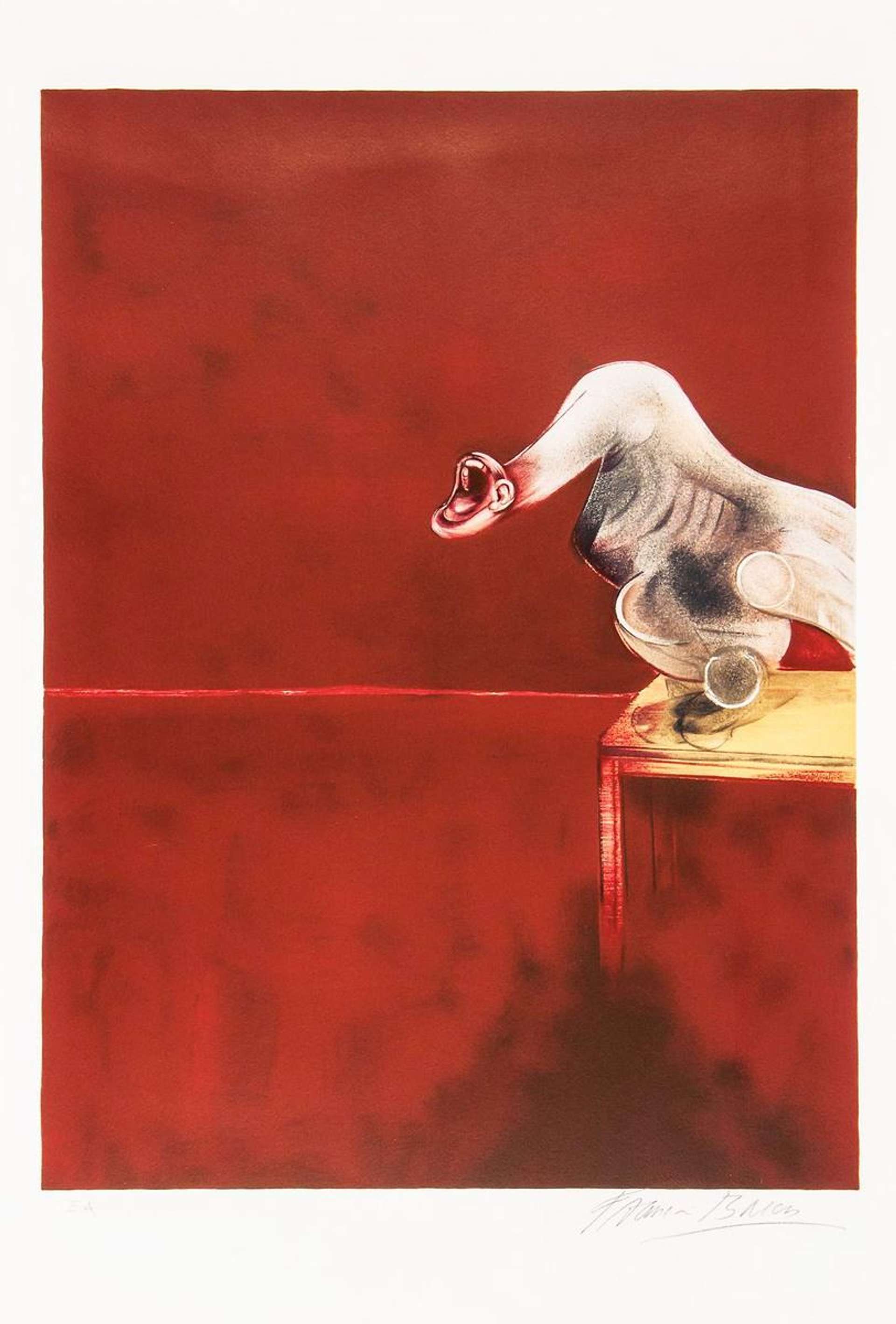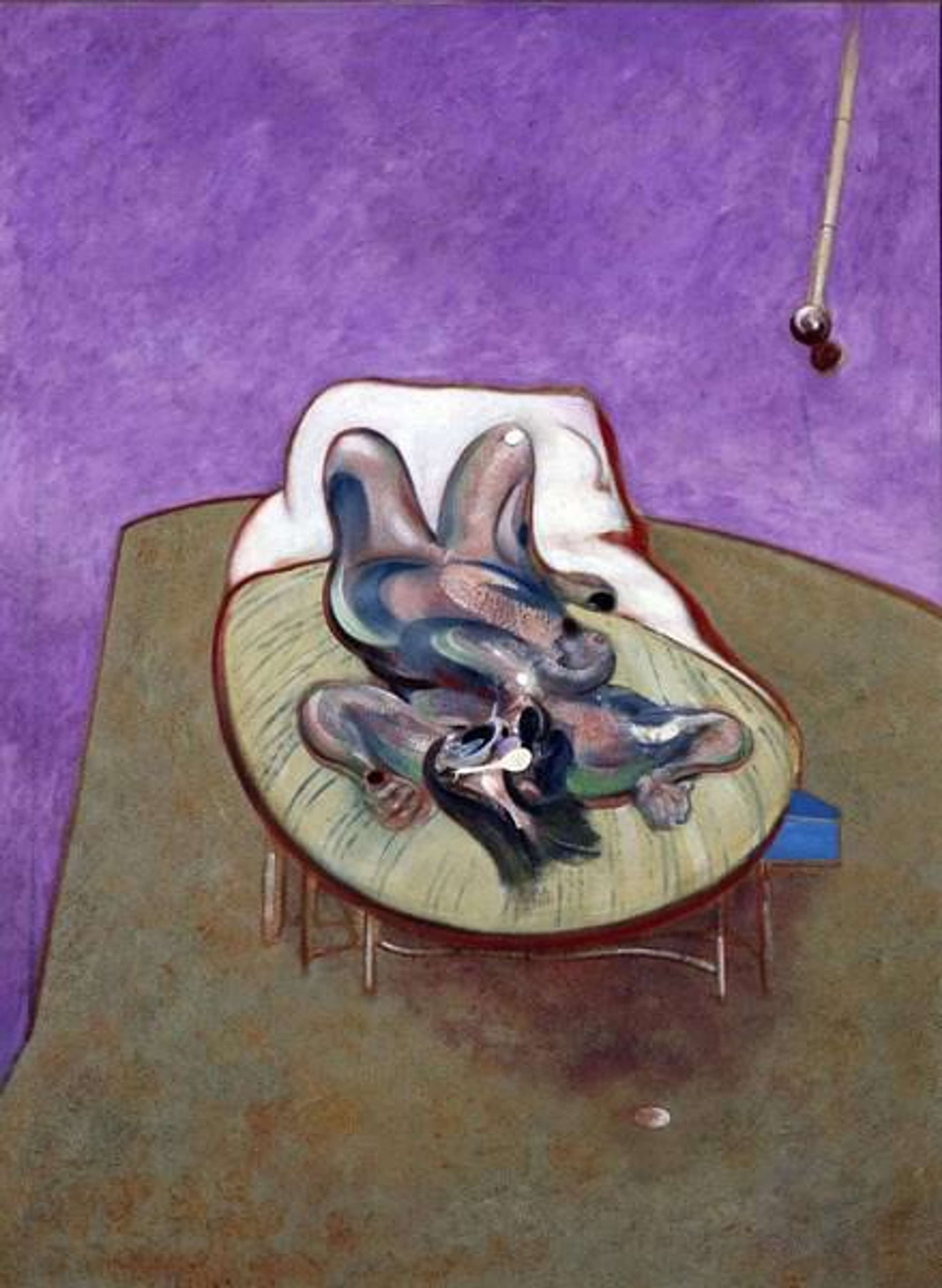Exploring the Psychoanalytic Themes in Francis Bacon's Art

 Study For Head Of Lucian Freud © Francis Bacon 1967
Study For Head Of Lucian Freud © Francis Bacon 1967
Francis Bacon
58 works
Francis Bacon (1909-1992) was an Irish-born British painter known for his raw, visceral images that often depict the darker aspects of the human psyche. As one of the most influential and enigmatic artists of the 20th century, Bacon's work continues to provoke curiosity and unease among critics and art enthusiasts alike. His style was characterised by a unique blend of abstraction and figurative representation, often portraying contorted figures that convey a sense of angst, isolation, and despair. Through analysis of his works, we can explore the psychoanalytic themes present in his figurative art and understand its impact on the viewer.
Unlocking the Connection Between Art and Psychology in Bacon's Works
Psychoanalytic theory, developed primarily by Sigmund Freud, provides a framework for understanding human behaviour, motivation, and the unconscious mind. In essence, psychoanalysis seeks to uncover the hidden forces that drive and influence our thoughts, feelings, and actions. Francis Bacon's art can be analysed through the lens of psychoanalytic theory, as his works often delve into the complexities of the human mind and its darker recesses. Exploring the relationship between his art and psychology can provide a deeper understanding of the artist's work.
The powerful and often unsettling imagery present in Bacon's paintings also has a profound psychological impact on the viewer. By exploring themes such as the subconscious, the grotesque and sexuality, Bacon's art provides a unique window into the psyche and its complex emotions. Through an examination of the relationship between art and the mind, we can gain a deeper appreciation of the ways in which Bacon's work engages with our innermost fears and desires, as well as the transformative power of art in shaping our perceptions and experiences.
Exploring the Powerful Influence of the Subconscious Mind in Francis Bacon's Paintings
Bacon's art was deeply influenced by his personal life, and especially his troubled upbringing and tumultuous relationships. His paintings often reveal the influence of the subconscious mind, as they depict haunting images that suggest repressed desires, fears, and emotions. For example, Bacon's famous Three Studies For Figures At The Base Of A Crucifixion (1944) portrays three monstrous contorted figures, which can be interpreted as the artist's expression of his fears and anxieties. The role of the subconscious in Bacon's art is a testament to the power of art in exploring the depths of human experience.
While Bacon's work often delves into the darker aspects of the human psyche, it also offers a valuable opportunity for reflection and self-exploration. By confronting these challenging themes and emotions through art, viewers can gain a better understanding of their own psychological state and potentially achieve a greater sense of self-awareness and personal growth. In this way, Bacon's art serves as a powerful reminder of the therapeutic potential of art and its ability to promote mental health and well-being.
Surrealism and Distortion in Bacon's Art: The Impact of Perception on Its Unique Visual Language
While Bacon's work cannot be categorised strictly as Surrealist, it shares some similarities with the movement, particularly in its exploration of the subconscious and the distortion of figures. Bacon's paintings often depict dreamlike, surreal scenes that blur the boundaries between the conscious and unconscious mind. His use of distortion and disfigurement conveys a sense of unease and ambiguity and reflects the complex, often contradictory nature of the human psyche. Bacon's work explores the relationship between art and perception, as well as the ways in which art can challenge and shape our understanding of reality.
Bacon's distinctive approach to figurative art sets him apart from many of his contemporaries. By employing distortion, disfigurement, and abstraction, Bacon challenges traditional notions of beauty and representation in art. His unique style not only reflects his own personal experiences and psychological state but also seeks to express the complexities of the human condition. In this way, Bacon's art provides a valuable exploration of the relationship between art and representation, and the ways in which artists can defy established conventions to create innovative, thought-provoking works.
The Grotesque in Bacon's Art: The Profound Connection Between Art and the Human Condition in His Disturbing Imagery
Bacon's paintings frequently feature grotesque, distorted figures that reveal the darker side of the human condition. These images often explore themes such as violence, suffering, and despair, which are closely linked to the artist's own experiences and psychological state. The grotesque imagery in Bacon's work can be seen as a manifestation of the repressed, unconscious aspects of the human psyche. By examining these images, we can gain insight into the human condition and how art can serve as a powerful means of expressing our deepest fears and desires.
To fully appreciate Bacon's work, it is essential to consider the symbolic elements present in his paintings. The distorted figures, grotesque imagery, and surreal scenes that populate his canvases are rich with meaning, and understanding these symbols as a reflection of the artist’s mental state can help to illuminate the underlying emotions at play. By interpreting the symbolism in Bacon's art, we can gain a deeper understanding of the artist's intentions and the complex psychological landscape that his work represents.
Francis Bacon's Indelible Mark on Art History and His Influential Role in British Art
As a prominent figure in British art, Bacon's work has left a lasting impact on art history. His unique approach to painting and his exploration of psychoanalytic themes have solidified his place as one of the most important artists of the 20th century. Bacon's influence on subsequent generations of artists, as well as his contributions to the development of modern art, cannot be understated. His art provides a valuable insight into the cultural and psychological context of his time and has become an essential part of the canon of British art history. Bacon’s work also engaged with other important artists from the past and present, including his friendship with Lucian Freud and his reinterpretation of Vincent van Gogh.
As with any significant artist, his work has been subject to extensive critique and analysis. This critical engagement with Bacon's art not only helps to clarify the meaning and significance of his paintings but also serves as a valuable tool for exploring the broader themes and issues that are central to the study of art and art history.
Revealing the Intimate Link Between Art and Identity in Francis Bacon's Provocative Exploration of Human Desire
Sexuality is another prominent theme in Bacon's art, with many of his works exploring the darker, more primitive aspects of human desire. His paintings often feature nude or semi-nude figures engaged in acts of violence or intimacy and these themes can be seen as an expression of Bacon's own conflicted homosexuality. They also offer a broader exploration of the human subconscious and its powerful, often destructive impulses. By examining the role of sexuality in Bacon's art through the lens of various theories, including psychoanalysis, we can better understand the relationship between art and sexual identity, and the ways in which it can express deeply personal experiences and emotions.
The Lasting Legacy of Francis Bacon's on Psychoanalytic Thought and Modern Art
Through a psychoanalytic lens, Bacon's art reveals a profound exploration of the human psyche and its darker, more complex dimensions. His paintings often delve into themes of the subconscious, the grotesque, surrealism and sexuality, providing a unique and unsettling glimpse into the inner workings of the mind. By examining Bacon's works through this theoretical framework, we can gain a deeper understanding of the motivations, desires, and fears that shaped him as an artist, and ultimately, shed light on the universal aspects of the human condition that continue to captivate and challenge us today. In addition, the exploration of Bacon's art through the lens of psychoanalysis also highlights the interconnectedness of art and various aspects of human experience, such as trauma, perception, philosophy and consciousness. By engaging with these themes, we can better appreciate the power of art to transform, challenge, and enlighten our understanding of ourselves and the world around us.
Bacon's art remains an essential part of the canon of art history, and his exploration of psychoanalytic themes has left a lasting impact on the fields of art and psychology. His work serves as a testament to art’s ability to provide a unique window into the complexities of the human mind and condition. This theme continues to be explored, powerfully exemplified in Francis Bacon: Human Presence, an exhibition at the National Portrait Gallery that highlighted his intense portrayals of the human figure. The exhibition underscored Bacon’s ability to capture raw emotion and existential angst, reinforcing his reputation as a master of psychological expression. As we continue to study and appreciate Bacon's work, we are reminded of the enduring importance of art in our lives and its capacity to reveal the hidden depths of our innermost thoughts, feelings, and desires.












